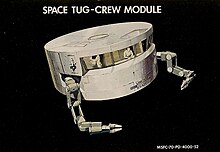Space Humanity Program
Search
Space tug
Read in another languageWatch this pageEdit
Reusable, modular 1969 NASA vision Space Tug (canceled)
A space tug is a type of spacecraft used to transfer spaceborne cargo from one orbit to another orbit with different energy characteristics. An example would be moving a spacecraft from a low Earth orbit (LEO) to a higher-energy orbit like a geostationary transfer orbit, a lunar transfer, or an escape trajectory.
The term is often used to refer to reusable, space-based vehicles. Some previously proposed or built space tugs include the NASA 1970s STS proposal[1] or the proposed Russian Parom, and has sometimes been used to refer to expendable upper stages,[1]such as Fregat,[2] or Spaceflight IndustriesSherpa.
BackgroundEdit
The space tug was first envisioned in the post-World War II era as a support vehicle for a permanent, Earth-orbiting space station. It was used by science fiction writer Murray Leinster as the title of a novel published in 1953 as the sequel to Space Platform, another novel about such a space station. [3]
NASA Space Transportation SystemEdit
Space Tug crew module concept
A reusable space tug was studied by NASA in the late 60s and early 70s as part of a reusable Space Transportation System (STS). This consisted of a basic propulsion module, to which a crew module or other payload could be attached. Optional landing legs could be added to land payloads on the surface of the Moon.[1] This, along with all other elements of STS except the Space Shuttle, was never funded after cutbacks to NASA's budget during the 1970s in the wake of the Apollo program.[4]
Space Shuttle eraEdit
Expendable upper stagesEdit
The Shuttle program filled the role of high-energy orbital transfer by the development[when?] of a solid-fueled single-stage Payload Assist Module and two-stage Inertial Upper Stage.[citation needed]
A more powerful liquid hydrogen fueled Centaur-G stage was developed for use on the Shuttle, but was cancelled as too dangerous after the Challenger disaster.[5]
Orbital Maneuvering VehicleEdit
NASA studied another space tug design, termed the Orbital Maneuvering Vehicle (OMV), along with its plans for Space Station Freedom. The OMV's role would have been a reusable space vehicle that would retrieve satellites, such as Hubble, and bring them to Freedom for repair or retrieval, or to service uncrewed orbital platforms.[6][7] In 1984, the Orbital Maneuvering Vehicle (OMV) preliminary design studies were initiated through a competitive award process with systems studies conducted by TRW, Martin Marietta Aerospace, and LTV Corporation.[8]
Twenty-first century proposalsEdit
ParomEdit
Main article: Parom
The Russian RKK Energia corporation proposed a space tug named Parom in 2005[9]which could be used to ferry both the proposed Kliper crew vehicle or uncrewed cargo and fuel resupply modules to ISS.[10]Keeping the tug in space would have allowed for a less massive Kliper, enabling launch on a smaller booster than the original Kliper design.
SHERPAEdit
Main article: SHERPA (space tug)
Spaceflight Inc. developed SHERPA, which builds upon the capabilities of the Spaceflight Secondary Payload System (SSPS) by incorporating propulsion and power generation subsystems, which creates a propulsive tug dedicated to maneuvering to an optimal orbit to place secondary and hosted payloads. The maiden flight is scheduled for November 2018 on a Falcon 9rocket, and it consists of two separate unpropelled variants of the dispenser. This flight will deploy more than 70 small satellites from 18 countries.[11]
VASIMREdit
The VASIMR electric plasma rocket could be used to power a high-efficiency space tug, using only 9 tons of Argon propellant to make a round trip to the moon, delivering 34 tons of cargo from Low Earth Orbit to low lunar orbit. As of 2014, Ad Astra Rocket Company had put forward a concept proposal to utilize the technology to make a space tug.[12][needs update]
ISRO PAM-GEdit
Indian Space Research Organisation has built an upper stage called PAM-G (Payload Assist Module for GSLV) capable of pushing payloads directly to MEO or GEO orbits from low Earth orbits.[13][14] PAM-G is powered by hypergolic liquid motor with restart capability, derived from PSLV's fourth stage. As of 2013, ISRO has realized the structure, control systems, and motors of PAM-G and has conducted hot tests.[15][16][17] PAM-G would form the fourth stage of GSLV Mk2C launch vehicle,[18] sitting on top of GSLV's cryogenic third stage.
JupiterEdit
Main article: Jupiter (spacecraft)
Lockheed Martin made a concept proposal to NASA in 2015 for a design called the Jupiterspace tug, to be based on the designs of two earlier Lockheed Martin spacecraft—Mars Atmosphere and Volatile Evolution Missionand the Juno—as well as a robotic arm from MDA derived from technology used on Canadarm, the robotic arm technology previously used on the Space Shuttle. In addition to the Jupiter space tug itself, the Lockheed concept included the use of a new 4.4 m (14 ft)-diameter cargo transport module called Exoliner for carrying cargo to the ISS.Exoliner is based on the earlier (2000s) ESA-developed Automated Transfer Vehicle, and was to be jointly developed with Thales Alenia Space.[19][20][21] In the event, NASA did not agree to fund the Jupiter development, and Lockheed Martin is not developing the tug with private capital.
See also
Other sources
References
Bibliography
Last edited 5 months ago by an anonymous user
RELATED ARTICLES
proposed space tug spacecraft

Content is available under CC BY-SA 3.0 unless otherwise noted.


Comments
Post a Comment